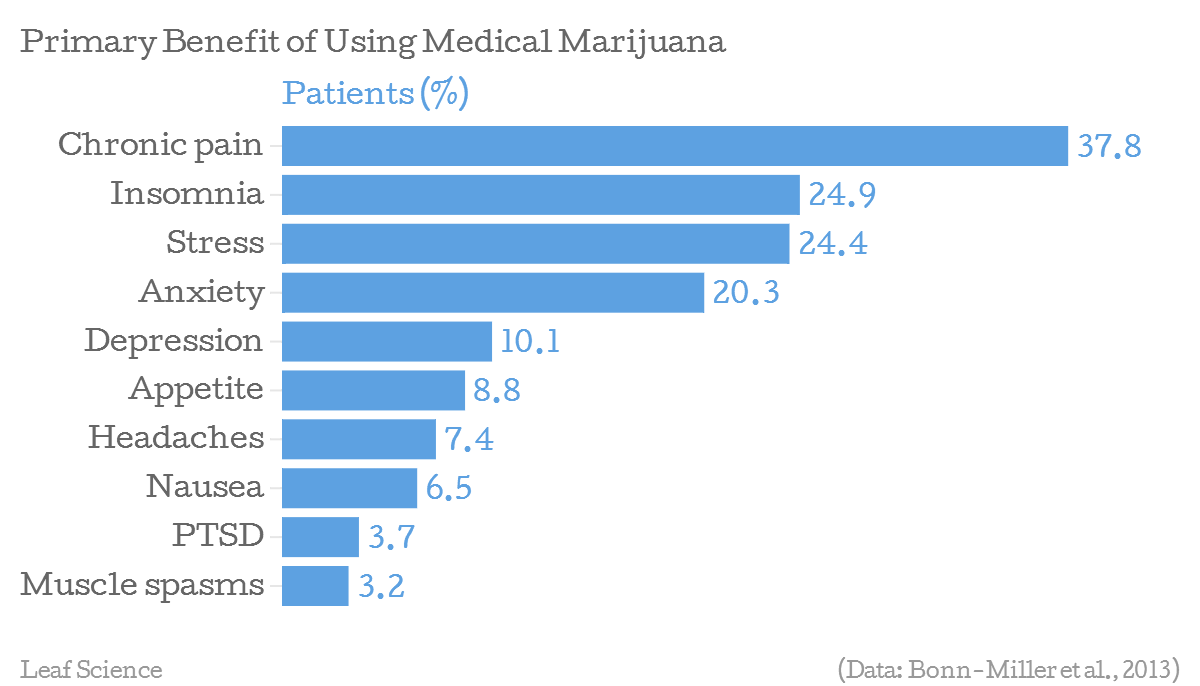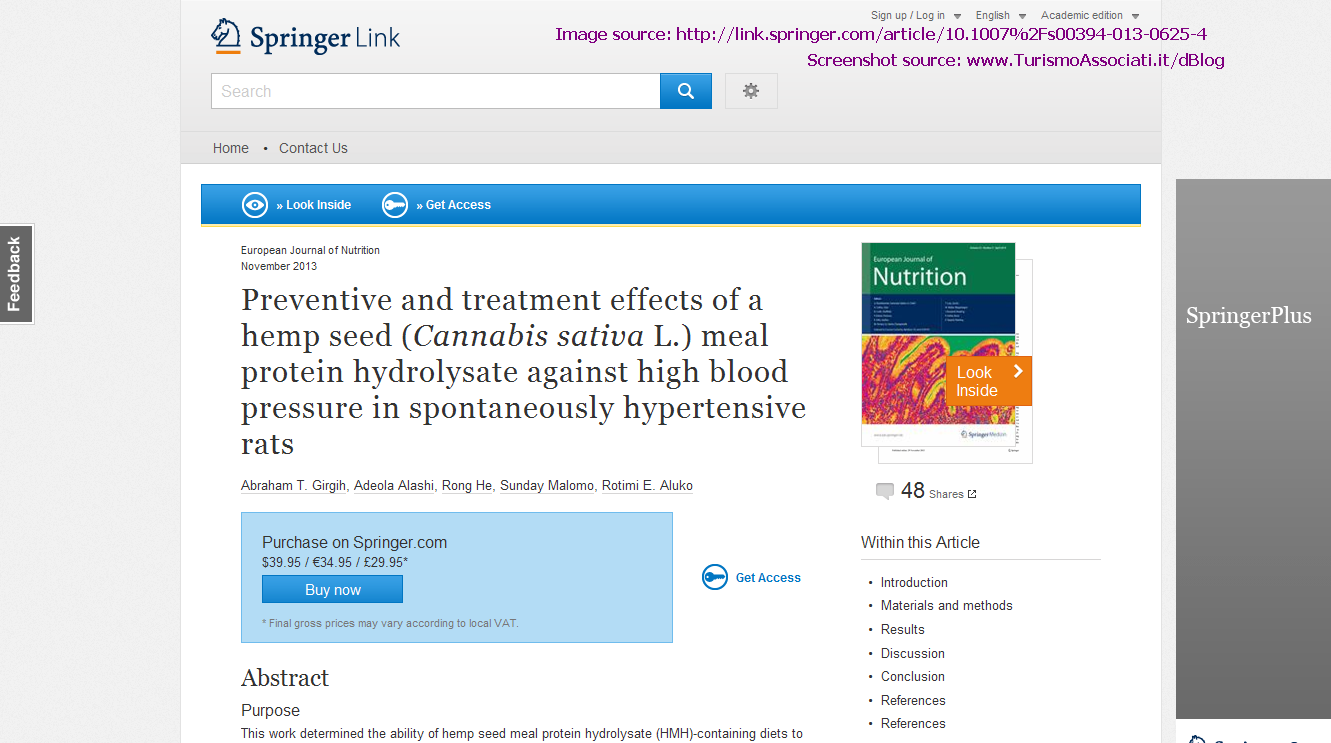|
Di seguito gli interventi pubblicati in questa sezione, in ordine cronologico.
While clinical trials are lacking, surveys of patients have helped researchers identify the most common reasons for using medical marijuana.
Recently, a team at the VA Palo Alto Health Care System surveyed 217 patients at a dispensary in California to find out what cannabis might be helpful for.
These were the results (patients could choose more than one):

The survey also revealed a much longer list of uses, but reported less commonly. The entire list of benefits reported by patients were:
"HIV/AIDS, nightmares, arthritis, glaucoma, cancer, attention deficit disorder/attention deficit hyperactivity disorder, neuropathy, asthma, seizures, bipolar disorder, Crohn's disease, epilepsy, hepatitis C, emotion regulation, restless leg syndrome, broken back/spinal cord injury, diabetes, hypertension, irritable bowel syndrome, multiple sclerosis, premenstrual dysphoric disorder, sciatica, recovery from surgery, alcohol over-consumption, allergies, borderline personality disorder, boredom, breathing, symptoms related to being burned, carpal tunnel, tendinitis, chronic fatigue syndrome, cyclical vomiting syndrome, dermatomyositis, digestions/polyps, Dupuytren's contracture, fibromyalgia, former lateral epicondylitis, gastroparesis, Grave's disease, hydrocephalus, intestinal bleeding, lack of motivation, leg cramps, loss of arm, neuralgia, post-viral refractory fatigue, tapering off opiates, tenosynovitis, anger and mood swings."
Contrary to popular belief, it appears it's not just pain that marijuana can be good for.
Source: LeafScience
Featured information: Windows App Certification Kit; Windows Software Development Kit (SDK) for Windows 8; Download Visual Studio 2012 Update 4; The Visual Studio 2012 Shell (Isolated) Redistributable Package contains the run-time binaries that are required to deploy an application that's based on the Visual Studio 2012 Shell (Isolated); Disable Program Compatibility Assistant in Windows 7 and Vista.

I have made a modified installer for the Windows Phone 8 SDK that will run on Windows 7 x64. I installed visual studio before I installed the SDK, but it shouldn't matter as this will install visual studio express for windows phone, if needed.
To install the SDK, perform the following:
1. Download the Windows Phone 8 SDK iso file. You can get it at this LINK
2. extract the contents of the ISO to the location of your choosing.
3. Download the modified "WPexpress_full.exe" that is attached to this post and use it to replace the one in the iso.
4. run setup as normal.
Everything will install and work.*
*I was getting an error when I launched the "Application Deployment" app. Once I updated Visual Studio 2012 to Update 3, it fixed it. EVERYTHING WORKS!!
Just wanted to add everything works 100%...I was able to recompile and deploy some xaps I wrote on my win 8 PC to my phone with no issues!
ATTACHED FILE LINK HERE.
Source: xda-developers
N.B. from TurismoAssociati:
Here is the LINK for the Visual Studio 2012 Update 4 (number 3 was updated)
You might, as we did, encounter two error messages that will stop the installation:
- Windows Software Development Kit Tools for Windows Store file sdksetup missing. LINK HERE for the download page.
- Microsoft Visual Studio 2012 Shell (Minimum) Vs_isoshell.exe Isolated missing. LINK HERE for instalation file.
You might need to Disable Program Compatibility Assistant in Windows 7 and Vista LINK HERE.
Before you submit your app for certification and listing in the Windows Store, use the Windows App Certification Kit to test your app and make sure it's ready to go. Here is the LINK with the solution.
P.S. Very important: Visual Studio 2012 will fail to install after October 7, 2013
When you try to install Visual Studio 2012 after October 7, 2013, you receive one of the following error messages:
Unable to locate package source
Microsoft Web Deploy 3.0
A required certificate is not within its validity period when verifying against the current system clock or the timestamp in the signed file.
WE CHANGED THE DATE AND TIME ON OUR MACHINE TO A PREVIOUS DAY BEFORE OCTOBER 2013, AND THE INSTALLATION WORKED!
Arturo Find for TurismoAssociati.it
Ingredients
4 cups of Cheez-Its
4 oz cannabis oil (for this recipe, we used 2 oz of bud for 4 oz of oil by volume)
Tinfoil
Baking pan

Directions
Preheat oven to 250F.
Place Cheez-Its in a large bowl.
Pour cannabis oil over crackers and gently toss to coat each piece.Spread crackers evenly on a baking pan covered in tinfoil.
Place in oven for 25 minutes. Once all the Weez-Its are lightly toasted and the oil has been absorbed, take them out of the oven.
Let cool for 15 minutes. Place in a handy jar for snacking.
Source: cookingwithcannabis
A group of researchers from the University of Glasgow in the UK have confirmed the ability of Sativex, a medicine derived from marijuana, to relieve severe chronic pain.
The study, published online Jan. 13 2014 in the European Journal of Pain, involved over 300 patients suffering from a type of nerve pain called peripheral neuropathic pain.
Neuropathic pain is "one of the most difficult types of pain to treat," the authors say. Half of all patients fail to gain adequate relief through standard therapies.

The 15-week study was conducted at 39 different treatment centers, most of them in the UK. By the end, 28% of patients that received Sativex showed clinically-significant pain relief verses 16% that received placebo.
Patients were allowed to adjust dosing themselves, and only minor symptoms such as dizziness and nausea were reported.
Besides pain relief, the researchers observed improvements in sleep symptoms as well, which they say is consistent with prior studies involving smoked cannabis and a synthetic THC pill called Marinol (or dronabinol).
Other studies have also explained how marijuana works to ease pain. By binding to receptors at both the brain and spinal level, compounds in the plant seem to interfere with how the nervous system transmits pain.
The drug used in the latest study, Sativex, is a whole plant extract containing equal concentrations of marijuana's two main ingredients, THC and CBD, along with minor levels of various terpenes and other cannabinoids found in the plant.
The drug is made by British drug company GW Pharmaceuticals and is administered as an oral spray.
The latest findings should help GW Pharmaceuticals with obtaining regulatory approval of Sativex for patients with neuropathic pain. So far, the drug has been approved in 24 countries for treating multiple sclerosis.
The study received funding from GW Pharmaceuticals
Source: LeafScience
Now that recreational marijuana has been legalized a whole new breed of tourist are visiting Colorado. It's pretty easy to acquire marijuana, however, finding 420 friendly accommodations is not so easy. It is not legal to smoke in public so don't try smoking in the parks or on the sidewalks. Here are a few things to consider when planning your cannabis vacation in Colorado.
1. Stay at a hotel that allows pot smoking. How do you know if a hotel is 420 friendly? Pick up the phone, call the front hotel, and ask. Be blunt (pun intended). If they say no then keep calling. Hotels have the right to decide if they wish to allow smoking, so you can be kicked out if you stay somewhere that doesn't allow it. Many of the large chains are going to say no.

2. Private residences. There are scores of locals who rent out a 420 friendly room for a reasonable rate. You can find these places through classifieds such as craigslist. Be very careful if you choose to go this route. Security is important so if a situation doesn't feel right then bail.
Here is a list of some of the 420 friendly accommodations including hotels and private residences in Colorado. Please call ahead to confirm a hotels marijuana policy as it may have changed.
3. Camping and smoking weed legally is more difficult that you think. State parks are a big no no, and national parks are obviously out. This leaves private campground and many have policies against marijuana. Again, if you plan to camp you may want to call ahead. *Many Coloradans claim that many campsites have policies against marijuana, but it is often tolerated as long as you are discrete about it. Use your best judgement, and stay out of state parks and federal land.
4. Do not smoke in a car. It doesn't matter if the car was parked or not. This can easily cause confusion which could possibly lead to you getting into some trouble.
5. Perhaps give edibles a try. They are much more discrete and can be consumed in any hotel room. If you have not done edible before then be very careful to take an appropriate dosage.
The laws are constantly changing, and can vary between cities. Always perform due diligence.
If you enjoyed this article about finding 420 friendly accommodations please use the share buttons below.
Source: maryjanesdiary
Di Salvatore Santoru
Recentemente Wikileaks ha pubblicato una bozza del trattato " TISA " (Trade in Services Agreement) , un'accordo riservato tra 50 paesi, il cui scopo sarebbe quello di cancellare il potere d'intervento dei governi e lasciare mano libera alle banche e alle multinazionali .
Come scritto da Marco Schiaffino sul Fatto Quotidiano, l'obiettivo dell'accordo è quello di " eliminare tutte le leggi nazionali che sono considerate come “ostacoli” al commercio dei servizi in ambito finanziario ", ovvero "un copione che ricalca i trattati approvati nel 2000 e che, secondo molti economisti e governi, hanno rappresentato la causa principale della recente crisi finanziaria globale ".

Tra le norme da eliminare, spiccano quelle relative ai limiti alle dimensioni degli istituti finanziari, imposti in alcuni paesi per evitare quelle operazioni di salvataggio obbligate nei confronti di quegli istituti ( principalmente banche ) considerati " troppo grandi per fallire ".
Nelle proposte del trattato inoltre si sollecita la privatizzazione della previdenza e delle assicurazioni e l'eliminazione degli obblighi di divulgazione di operazioni offshore nei paradisi fiscali.
Il trattato rappresenta una vera e propria proposta di deregulation totale per le banche e i grandi istituti finanziari, una sorta di manifesto per una prossima " dittatura finanziaria " di cui a beneficiarne saranno i pochi " signori del denaro " a scapito dei cittadini sempre più schiacciati da tasse e i cui soldi spesso sono usati proprio per salvare quegli istituti finanziari ( come nel caso delle vicende delle banche " too big too fail " ) in gran parte responsabili della crisi attuale .
Come avevo scritto in un recente articolo, il sogno dei gruppi di potere finanziario è : " un mondo completamente schiavo del denaro ( anche elettronico ) e totalmente mercificato , dove ogni individuo terrestre sia essenzialmente dipendente del sistema finanziario e privato di ogni radice . Un mondo totalitario unito dalla fede nel Dio Denaro e nei suoi creatori " .
Insomma,il cosiddetto " Nuovo Ordine Mondiale " .
Fonte: informazioneconsapevole.blogspot.it
There is a Facebook group called The Exposing The Truth Group (link here) that has a very fascist way of banning members who try to tell any truth. We will only post the two comments we made on the group and let you, the reader, "judge" the situation...
"I do not agree with what you have to say, but I'll defend to the death your right to say it." - Voltaire
Somebody in that group posted the image bellow with this text: "Imagine what our country would be like if we legalized explosives. Can you imagine a world where that wouldn't be a safety hazard? Then share this to stand up for sensible gun control!". So we, from TurismoAssociati.it made this comment: "Let me tell you this: I lived in a society where guns were illegal to possess and I never had a gun pointed in my face. Time passes and the same country made legal guns with rubber bullets: heard of many cases where people lost an eye from people shooting at strangers casually when angry... My opinion: nobody should have guns, not the police pigs or the damn military!" What happened? Some paranoid Admin, called Cairenn Day (link here) answered: "Bye F T (Ford Turani - TA note), I warned folks about the nasty names for police" and quickly banned us from the group!

The thing is many members of that group have doubts of the True intentions of the administrators... Michael A. Pizza: "I thought this sight is all about Exposing the Truth? What you showed us all has nothing to do about any truth. It just your arrogance that your Exposing. Enough said time to move on and close this account , you cannot explain things to people that don't have any common sense!" or Ayeisha Quinones: "... the truth evades you and everyone else with your mindset. It is what it is. ... the people who keep denying the negative impact of widespread guns in society are deniers."
But here you have one of the admins, Cairenn Day that infiltrated the group just to hide and censure any position of truth: "M A P, we are doing our best to get folks to stop believing every piece of nonsense on the web".
That group is full of brainwashed individuals: Janice Gordon: "Besides which, openly flaunting such weapons only serves to make you the first target a criminal is likely to go after. Much better to carry concealed, like I do."
Who are we, to explain to the americans that, in the United Kingdom for example, the police DO NOT carry a gun! They are not allowed. So, in this way are avoided the situations where some rookie or racist cop shoots by mistake any bystander...
Some other user posted this message on the group: Colleen Vanskiver: "/ExposingTheTruthGroup/ What a joke this group is" and a genius asked: Andrew Hudak: "Why would you join a group that you do not like?" But here comes the admin: Cairenn Day: "What is your objection here, please?", but you must read this:
Mario E Gilberto: "There are plenty of facts. I can, for example, show you 2000+ peer-reviewed studies which show that GMOs are safe. Many of them come from independent outlets. Isn't that creditable?" Cairenn Day: "I can show you how contrails form and that chemtrails are a hoax" Dee Junior: "Gmo's are probably safe it's the government control of their producers that concerns me!" Cairenn Day: "The government doesn't control farmers or companies."
We asked Aaron Jackson (link here), the main Admin of the group to insert us again and we posted: "With fascist admins like Cairenn Day, that ban members for stating "police pigs should not have guns".., this should be called the Hiding The Fascist Joke Group!" and Cairenn answered: "F T has been sent to the woodshed again". Four likes for her/his statement!

Need any other proof that this group has nothing to do with the truth and the freedom of expression? Our advice: be very careful with the FascistBook groups, because any group can become administrated by false "truthers" who infiltrate to divide and destroy... "None are more hopelessly enslaved than those who falsely believe they are free." - Johann Wolfgang von Goethe
This article is dedicated to Richard Clarke, a truth researcher who posted his findings and observations on FaceBook, until his account got reported or/and cancelled and there was no trace of him on the "CIA social network"...
Doru Trifan for www.TurismoAssociati.it
In a recent ‘Ask The Doctor’ column, Dr. Heather Auld, Fellow at the University of Arizona Department of Integrative Medicine and a practising obstetrician/gynecologist, explained why the time has come for marijuana to be placed back into the U.S. pharmacopeia.
1. Marijuana has been used as medicine for more than 3,000 years
The use of medical marijuana has been traced to ancient civilizations in China, India, and Egypt. One of the earliest pieces of evidence is a book written by Chinese Emperor Shen-Nung in 2737 BCE, which described the benefits of cannabis in treating constipation, gout, rheumatism and absent-mindedness.
Dr. Auld writes that “only in recent decades has it been removed from our pharmacies.”
2. The American Medical Association supports medical marijuana and its use in research
When marijuana prohibition was passed in 1937, the American Medical Association (AMA) was one of the only voices of opposition. Indeed, the AMA was well aware that marijuana, since entering Western medicine in the mid-1800s, was commonly prescribed for a wide range of conditions.
Though synthetic drugs grew popular during the 20th century, the AMA has continued to support research on marijuana’s medical potential, a position they maintain to this day.

3. The ‘high’ is only from one component
Cannabis contains more than 400 chemical compounds, of which more than 60 have been identified as cannabinoids. Cannabinoids are the medically active ingredients in cannabis, including the one that gets you high, tetrahydrocannabinol (THC).
But other cannabinoids are known to offer similar medical benefits, without the high. Cannabinoids like cannabidiol (CBD), cannabigerol (CBG), and tetrahydrocannabinolic acid (THC-A) have been extracted from cannabis to produce non-psychoactive forms of medical marijuana. These are especially popular for paediatric patients.
4. Our body contains a natural cannabinoid system that regulates health and illness
It wasn’t until the mid-1990s that scientists discovered why marijuana works so well, and for so many different illnesses. The discovery was a natural system in the human body called the endocannabinoid system, which includes chemicals that mimic the activity of cannabis, called endocannabinoids.
Much like cannabis, Dr. Auld notes that endocannabinoids act to “decrease inflammation, increase immunity, decrease pain, and increase appetite.”
5. Smoking or vaporizing marijuana is better for pain relief
Although some believe there are better methods than smoking or vaporizing, Dr. Auld argues that it could be ideal for those in pain. Oral ingestion of cannabis provides longer-lasting relief, but also takes about an hour to achieve effect. Patients in pain usually require more immediate action, which smoked or vaporized marijuana provides.
6. Marijuana may be superior to narcotic painkillers for neuropathy or nerve pain
While opioid painkillers are incredibly potent and can work wonders for certain types of pain, they are much less effective in cases of nerve pain. In studies, marijuana performs just as well as gabapentin, a leading pharmaceutical used to treat neuropathy.
Also, Dr. Auld notes that “whereas narcotics commonly increase nausea and vomiting, marijuana relieves those symptoms.”
7. When combined, marijuana can decrease the amount of narcotics needed for pain relief
Studies suggest that marijuana can reduce the need for prescription painkillers when given together. The popularity of painkillers has led to a rise in accidental overdoses in the U.S., with opioids claiming over 16,000 lives in 2010. By reducing the need for high doses, medical marijuana offers a promising solution for doctors and patients.
8. The main side effect of marijuana is euphoria or extreme feelings of well-being
One of the most common reasons for doctors to dismiss medical marijuana is the unwanted side effect of getting high. Yet those who have never experienced a marijuana high can easily forget what the high actually does. Feelings of euphoria, while unwanted for some, can provide comfort for patients with debilitating or chronic illnesses.
9. Unlike highly addictive narcotic painkillers, marijuana has the same addictive potential as caffeine
Even when compared to common recreational drugs, studies have ranked marijuana among the least addictive.
A study conducted by NIDA researchers concluded that 9% of people who ever try marijuana will become addicted to it at some point, which is similar to caffeine. On the other hand, the same study found an addictive potential of 15% for alcohol and 32% for tobacco.
10. Marijuana is being studied as a treatment for tumors and various forms of cancer
For cancer patients, relief of nausea and pain are not the only potential benefits of marijuana.
In fact, compounds in marijuana have shown anti-tumor and anti-cancer effects in numerous animal models, “particularly in brain and skin tumors,” Dr. Auld writes, “but also in lung cancer, lymphoma and colon cancer.”
Last November 2013, a drug company called GW Pharmaceuticals began the first clinical trials of a marijuana-based treatment for battling cancer.
Source: LeafScience with LINKS for each point!
Researchers at the University of Manitoba believe hemp seeds could offer a safer alternative to drugs traditionally prescribed for hypertension. Previous studies, they note, suggest that proteins found in hemp seed possess a variety of cardiovascular benefits.
"Preliminary in vitro studies have shown that industrial hemp seed peptides possess both antioxidant and antihypertensive properties."
In a new study, published in the European Journal of Nutrition, the team found that an 8-week diet of hydrolyzed hemp protein could slow the development of hypertension in genetically-prone rats.

What's more, the diet was also effective at reducing signs of hypertension – plasma ACE and renin levels – in rats with already established conditions.
"The results confirm the potential of HMH (hemp seed meal hydrolysate) as a useful ingredient that can be used to formulate functional foods and nutraceuticals for the prevention and treatment of hypertension."
While a number of foods have been found to help control blood pressure, the researchers suggest that the protein content of hemp seeds, as well as being easy to digest, make it an ideal choice.
"The presence of superior amino acid profile in hemp seed proteins (principally identified as edestin and albumin) and high digestibility promotes their efficacy as a source of health-enhancing bioactive peptides."
Despite the positive results, more work still needs to be done. The team says the next step is to identify and purify the protein sequences responsible for its antihypertensive effects.
The study received funding from the Manitoba Agri-Food Research and Development Initiative (ARDI) and the Natural Sciences and Engineering Research Council of Canada (NSERC)
Source: LeafScience
Here we count down, in no particular order, a few (of the many) reasons why this year was memorable for cannabis research.

1. FDA approves first clinical trials of marijuana for paediatric epilepsy
Evidence that marijuana can help in a wide range of epileptic conditions dates back to the 70s. But it wasn’t till this year that research progressed to the stage of FDA-approved clinical trials.
Likely due, at least in part, to growing interest from the media and awareness among parents with epileptic children, a company called GW Pharmaceuticals this year became the first ever to initiate clinical trials of a cannabis-based epilepsy treatment. The drug is called Epidiolex and is a liquid extract high in the non-psychoactive marijuana chemical called cannabidiol (CBD).
Initial results are expected early 2014 and, if successful, may not just bring relief to thousands of children across the U.S for whom traditional medicines don’t work. In fact, clinical evidence that cannabis extract helps in paedetric epilepsy could very well lead to the rescheduling of cannabis under U.S. federal law.
Read more: New Cannabis Drug Approved For Trials In Children With Epilepsy
2. Scientists show that various chemicals in marijuana can kill leukemia cells
Evidence that marijuana can kill cancer cells has also existed for decades. But this year, research from the University of London revealed something very interesting.
Using leukemia cell lines, the study identified the cancer-fighting potential of a number of lesser known, non-psychoactive chemicals in marijuana.
Unlike THC, the compounds that were used in the study – cannabidiol (CBD), cannabigerol (CBG) and cannabigevarin (CBGV) – can’t get patients high. Significant media attention was paid to this point. On the other hand, it’s doubtful that getting high is a major concern of anyone battling cancer.
Read more: Cannabinoids Destroy Leukemia Cells, New Study Finds

3. First clinical trials of marijuana for brain cancer begin in the UK
On top of breakthroughs in non-psychoactive cannabis treatments, 2013 also marked the launch of the first ever human trials of cannabis-based cancer medicine.
In November, GW Pharmaceuticals announced the start of Phase 1b/2a clinical trials of their pharmaceutical cannabis spray, Sativex, as an add-on treatment for aggressive brain cancer. The two-part trial involves giving Sativex to 20 patients with recurrent gliobastoma multiforme, in addition to the standard chemotherapy drug temozolomide.
While THC and CBD have both been shown to kill cancer cells on their own, some research suggests that combining marijuana compounds with traditional chemotherapy drugs can have even greater anti-cancer effects.
Read more: Cannabis Treatment For Brain Cancer Begins First Human Trials
4. Researchers show that marijuana can help cigarette smokers quit
Marijuana may not just be a safer recreational drug than cigarettes, but apparently it can also help cigarette smokers quit. The first human study to investigate this was conducted at the University College London, with the results published September this year.
The small, placebo-controlled trial involved the non-psychoactive marijuana compound CBD administered via vaporizer, which subjects were instructed to use whenever they felt the urge to smoke.
After one week of treatment, those who received actual CBD showed a 40% reduction in the number of cigarettes smoked, compared to the placebo group. The researchers concluded that the results were promising, but since the study only involved 24 subjects, larger studies are still needed.
Read more: Can Marijuana Help You Quit Cigarettes? Study Says Yes
5. Scientists provide first clinical evidence that marijuana helps in Crohn’s disease
In May, researchers out of Israel published results from the first human study investigating smoked medical marijuana as a treatment for Crohn’s disease. While the study was rather small, only 11 patients were involved, daily doses of medical marijuana led to complete remission in 5 of the patients.
Medical marijuana also helped patients wean themselves from dependency on steroid-based medications and improved their appetite and sleep, with “no significant side effects.”
While the study focused mostly on symptom measurements, the results may also support earlier findings from animal studies showing that compounds in marijuana can actually treat the underlying cause of Crohn’s and other inflammatory bowel diseases.
Read more: Cannabis induces a clinical response in patients with Crohn’s disease: a prospective placebo-controlled study.
6. Scientists provide first clinical evidence that marijuana helps in Parkinson’s disease
With animal and cell culture studies suggesting that marijuana may slow the progression of Parkinson’s, it was only a matter of time until human research was conducted.
Thankfully, Israeli researchers also published the first ever human study of medical marijuana for Parkinson’s this year. Although only 20 patients were involved, the results showed clear improvements in symptoms of tremor, rigidity and bradykinesia.
Patients also reported a dramatic reduction in pain associated with their disease, which led to improvements in sleep. Overall, measurements of disease severity taken after patients smoked medical marijuana showed a significant decline that lasted for around 2 to 3 hours.
Read more: Smoking Pot Eases Tremors in Parkinson’s
7. Harvard study shows smoking marijuana may make you skinnier and reduce the risk of diabetes
This year, an observational study involving over 4,600 adults, conducted at Harvard University, revealed a rather surprising link between marijuana use and slimmer waist lines.
Although suggested before, the link still seems counter-intuitive, since marijuana isn’t known for reducing food intake, but rather the opposite. Indeed, other studies suggest that marijuana users have a significantly higher calorie intake than non-users.
However, the Harvard study also found lower levels of insulin blood levels and insulin resistance among marijuana users, as well as higher levels of the ‘good’ type of cholesterol (HDL), all of which are believed to lower the risk of diabetes.
Considering the newest data, the researchers concluded that while marijuana is well known for stimulating a desire for unhealthy foods, it may have some less obvious metabolic effects that could be healthy in the long run.
Read more: Marijuana: The Next Diabetes Drug?
Source: LeafScience
|